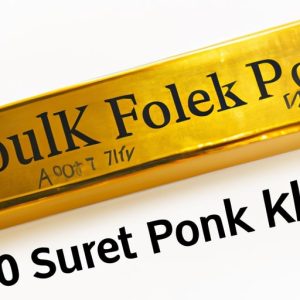
The decision to invest in precious metals, particularly gold, has been a topic of debate for investors seeking to diversify their retirement portfolios. One avenue of exploration is putting one’s 401(k) funds into gold.
This article delves into the advantages and disadvantages of this strategy, aiming to provide a comprehensive perspective on whether allocating your hard-earned retirement savings to gold is a prudent choice.
The Case for Investing in Gold within a 401(k)
- Portfolio Diversification: Gold is often considered a safe-haven asset that can act as a hedge against economic downturns and market volatility. Including gold in your 401(k) can help mitigate risk, as it tends to have a low correlation with traditional assets like stocks and bonds. Diversification is crucial for maintaining stable returns, especially during turbulent times.
- Inflation Protection: Gold has historically maintained its value during periods of high inflation. When the purchasing power of fiat currencies erodes, the value of gold tends to rise. As a long-term investment, holding gold in your 401(k) can provide a potential safeguard against the erosive effects of inflation.
- Steady Long-Term Growth: While gold may not generate the same explosive returns as equities during bull markets, it has displayed steady long-term growth. This is why so many people are wanting to know how to convert a 401k to physical gold. It’s also important to know, this can be particularly appealing for conservative investors who prioritize capital preservation over rapid gains.
The Drawbacks of Gold Investment in a 401(k)
- Lack of Income Generation: Unlike dividend-paying stocks or interest-bearing bonds, gold does not provide any income. In a retirement account, consistent income generation is essential for retirees who depend on their investments to cover living expenses.
- No Dividend Growth: Companies that issue dividends can increase their payouts over time, providing a source of growing income. Gold, on the other hand, does not experience dividend growth, potentially resulting in a lack of real income growth over the years.
- Volatility and Speculative Nature: While gold is often touted as a safe-haven asset, it’s not immune to volatility, which you can learn more about here. Its value can be influenced by geopolitical events, economic indicators, and supply-demand dynamics. Investing in gold requires a certain tolerance for short-term price fluctuations.
Considerations for Your 401(k) Gold Investment
- Allocation Size: The amount you allocate to gold within your 401(k) should be carefully considered. Experts often recommend a moderate allocation, around 5-10% of your total portfolio. This strikes a balance between diversification benefits and potential drawbacks.
- Expertise and Timing: Successfully investing in gold requires a deep understanding of market trends, supply-demand dynamics, and economic indicators. Attempting to time the market (https://www.schwab.com/learn/story/does-market-timing-work) can be risky, and individuals without sufficient knowledge may struggle to make informed decisions.
- Storage and Costs: If you decide to invest in physical gold, storage and security become important concerns. Custodial fees and storage expenses can eat into your returns, impacting the overall effectiveness of the investment.
What You Need to Think About
Investing in gold within your 401(k) can provide diversification and protection, but it’s crucial to adopt effective strategies to maximize your returns and minimize potential penalties. This article explores techniques to optimize your gold investments and navigate potential challenges successfully.
1. Educate Yourself
The first step in maximizing your gold investment is to educate yourself about the precious metals market. Understand the factors that influence gold prices, such as economic indicators, geopolitical events, and supply-demand dynamics. Stay informed through reputable financial news sources, research reports, and market analyses.
2. Diversify Thoughtfully
While gold can be an important diversification tool, avoid putting all your 401(k) funds into this single asset. Aim for a balanced allocation that includes a mix of stocks, bonds, and other assets. This approach helps mitigate risk and ensures that your retirement portfolio remains well-rounded.
3. Choose the Right Gold Investment Vehicle
There are various ways to invest in gold, including physical gold, gold ETFs (exchange-traded funds), and gold mining stocks. Each option has its advantages and drawbacks. Physical gold can provide direct ownership but may involve storage costs. Gold ETFs offer convenient trading but come with expense ratios. Gold mining stocks can provide exposure to the gold industry but carry stock market risks. Carefully assess your preferences and risk tolerance before selecting the right investment vehicle.
4. Understand Tax Implications
Gold investments within a 401(k) are subject to specific tax rules. Contributions to a traditional 401(k) are made with pre-tax dollars, while distributions in retirement are taxed at your ordinary income tax rate. In contrast, Roth 401(k) contributions are made with after-tax dollars, and qualified distributions are tax-free. Consider consulting a tax advisor to determine which type of 401(k) aligns best with your investment strategy and financial goals.
5. Minimize Penalties through Proper Withdrawal Strategies
Withdrawals from a 401(k) before the age of 59½ typically result in early withdrawal penalties and taxes. However, there are exceptions. The IRS allows for penalty-free withdrawals for certain hardships, medical expenses, and first-time home purchases. Additionally, if you leave your job at age 55 or later, you can take penalty-free withdrawals from your current employer’s 401(k), though taxes will still apply. Understanding these exceptions can help you avoid unnecessary penalties.
6. Consider a Rollover to an IRA
If you’re concerned about potential penalties or limitations of your employer-sponsored 401(k), consider rolling over your funds into a traditional IRA or a Roth IRA. IRAs often provide more investment options, increased control over your investments, and potentially lower fees. Be aware of the tax implications and potential restrictions associated with rollovers.
7. Regularly Review and Rebalance
Markets evolve, and so should your investment strategy. Regularly review your portfolio’s performance and rebalance as needed to maintain your desired asset allocation. A disciplined approach to rebalancing ensures that your gold investment remains aligned with your overall financial goals.
Investing 401(k) Funds in Gold: What You Should Know
Choosing to invest your 401(k) in gold involves more than simply following market trends—it requires a thoughtful assessment of your long-term financial goals, risk tolerance, and overall investment knowledge. While gold is often seen as a hedge against inflation and economic uncertainty, it doesn’t generate income like dividends or interest and can experience significant price fluctuations.
For investors considering gold, it’s important to treat it as one component of a diversified portfolio rather than a standalone solution. A balanced approach—integrating gold with other asset classes—can help manage risk and improve resilience during market volatility.
Before making any moves, it’s wise to evaluate how gold fits into your broader retirement strategy. Speaking with a certified financial advisor can help you weigh the pros and cons based on your unique circumstances, ensuring your investment decisions support your long-term objectives.



